power steering CHEVROLET SUBURBAN 1996 Owners Manual
[x] Cancel search | Manufacturer: CHEVROLET, Model Year: 1996, Model line: SUBURBAN, Model: CHEVROLET SUBURBAN 1996Pages: 486, PDF Size: 26.58 MB
Page 190 of 486
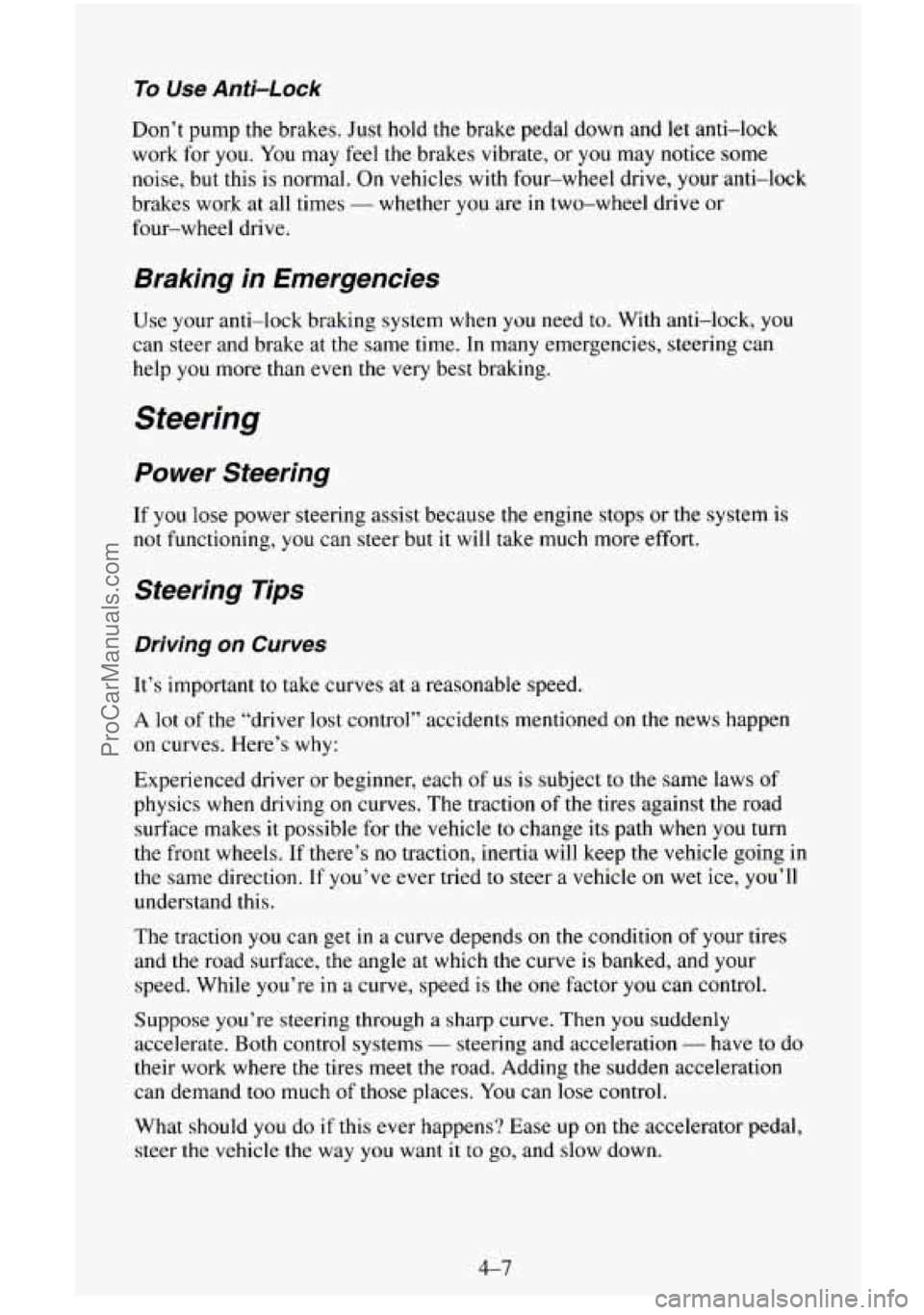
To Use Anti-Lock
Don’t pump the brakes. Just hold the brake pedal down and let anti-lock
work for
you. You may feel the brakes vibrate, or you may notice some
noise, but this is normal. On vehicles with four-wheel drive, your anti-lock
brakes work at all times
- whether you are in two-wheel drive or
four-wheel drive.
Braking in Emergencies
Use your anti-lock braking system when you need to. With anti-lock, you
can steer and brake at the same time. In many emergencies, steering can
help
you more than even the very best braking.
Steering
Power Steering
If you lose power steering assist because the engine stops or the system is
not functioning, you can steer but it will take much more effort.
Steering Tips
Driving on Curves
It’s important to take curves at a reasonable speed.
A lot of the “driver lost control” accidents mentioned on the news happen
on curves. Here’s why:
Experienced driver or beginner, each
of us is subject to the same laws of
physics when driving on curves. The traction
of the tires against the road
surface makes it possible for the vehicle to change its path when
you turn
the front wheels.
If there’s no traction, inertia will keep the vehicle going in
the same direction. If you’ve ever tried to steer a vehicle on wet ice, you’ll
understand this.
The traction
you can get in a curve depends on the condition of your tires
and the road surface,
the angle at which the curve is banked, and your
speed. While you’re in a curve, speed is the
one factor you can control.
Suppose you’re steering through a sharp curve. Then you suddenly
accelerate. Both control systems
- steering and acceleration - have to do
their work where the tires meet the road. Adding
the sudden acceleration
can demand
too much of those places. You can lose control.
What should you do if this ever happens? Ease up on the accelerator pedal,
steer the
vehicle the way you want it to go, and slow down.
4-7
ProCarManuals.com
Page 199 of 486
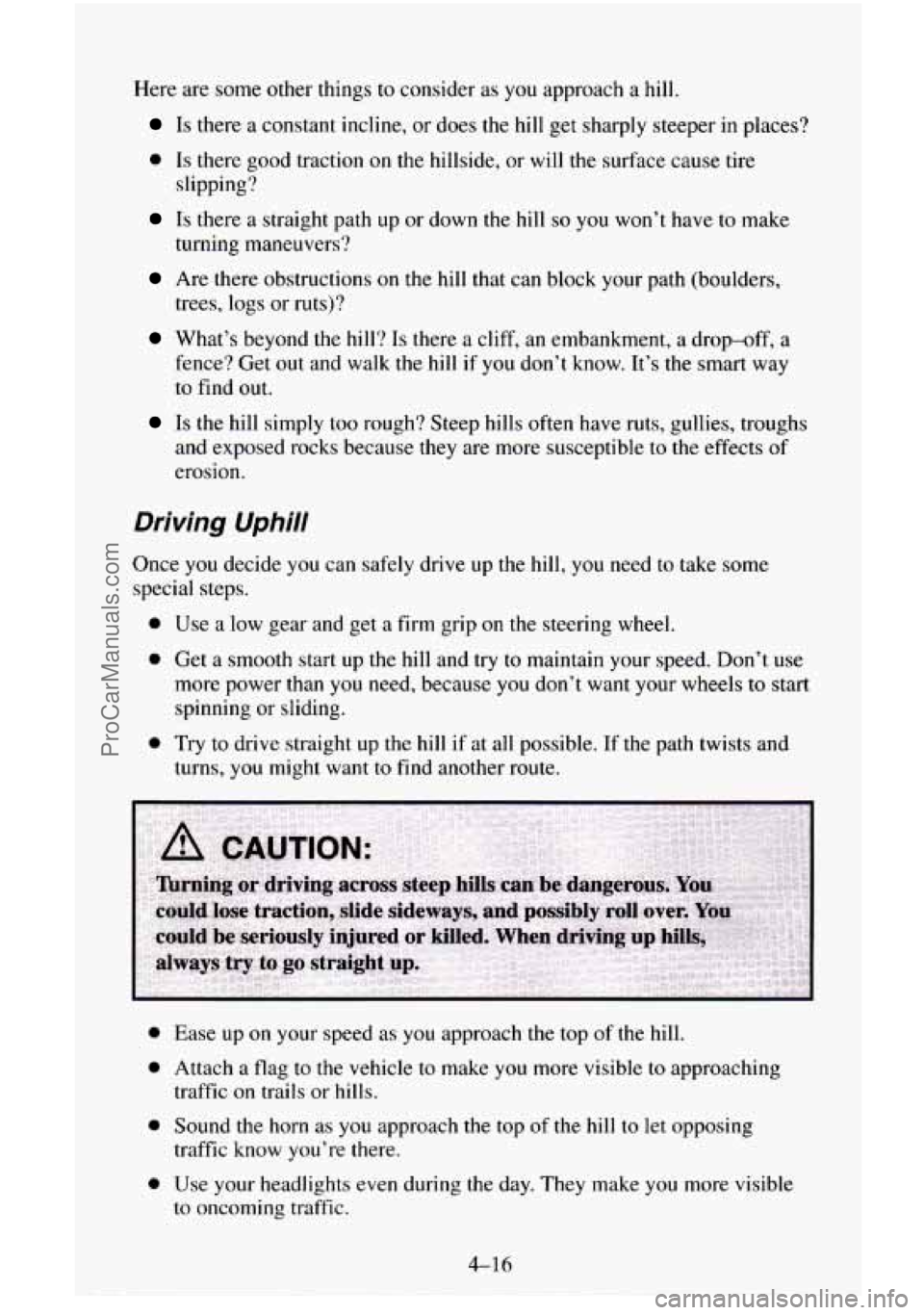
Here are some other things to consider as you approach a hill.
Is there a constant incline, or does the hill get sharply steeper in places?
0 Is there good traction on the hillside, or will the surface cause tire
slipping?
Is there a straight path up or down the hill so you won’t have to make
turning maneuvers?
trees, logs or ruts)?
Are there obstructions on the hill that can block your path (boulders,
What’s beyond the hill? Is there a cliff, an embankment, a drop-off, a
fence? Get out and walk the hill if you don’t know. It’s the smart way
to find out.
Is the hill simply too rough? Steep hills often have ruts, gullies, troughs
and exposed rocks because they are more susceptible to the effects
of
erosion.
Driving Uphi//
Once you decide you can safely drive up the hill, you need to take some
special steps.
0
0
0 Use a low gear and get a firm grip on the steering wheel.
Get a smooth start up the hill and try
to maintain your speed. Don’t use
more power than you need, because you don’t want your wheels to start
spinning
or sliding.
Try to drive straight up the hill if at
all possible. If the path twists and
turns,
you might want to find another route.
0
0
a
a
Ease up on your speed as you approach the top of the hill.
Attach a flag to the vehicle to make
you more visible to approaching
traffic
on trails or hills.
Sound the horn as
you approach the top of the hill to let opposing
traffic know you’re there.
Use your headlights even during the day. They make you more visible
to oncoming traffic.
4-16
. -
ProCarManuals.com
Page 316 of 486
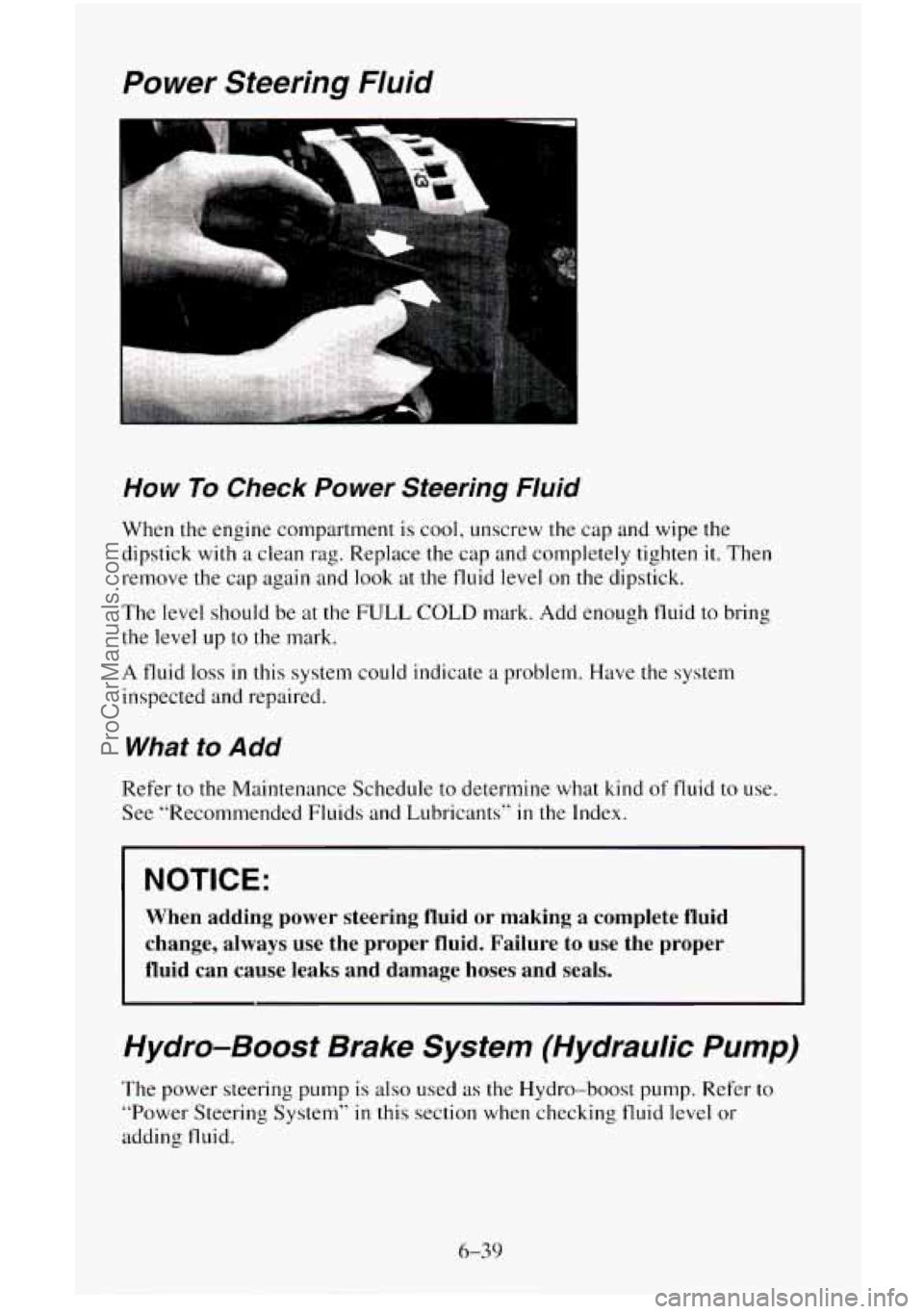
Power Steering Fluid
How To Check Power Steering Fluid
When the engine compartment is cool, unscrew the cap and wipe the
dipstick
with a clean rag. Replace the cap and completely tighten it. Then
remove the cap again
and look at the fluid level on the dipstick.
The level should be at the FULL COLD mark. Add enough fluid to bring
the level up
to the mark.
A fluid
loss in this system could indicate a problem. Have the system
inspected and repaired.
What to Add
Refer to the Maintenance Schedule to determine what kind of fluid to use.
See “Recommended Fluids and Lubricants”
in the Index.
I
I NOTICE:
When adding power steering fluid or making a complete fluid
change, always use the proper fluid. Failure to use the proper\
fluid can cause leaks and damage hoses and seals.
Hydro-Boost Brake System (Hydraulic Pump)
The power steering pump is also used as the Hydro-boost pump. Refer to
“Power Steering System” in this section when checking fluid level or
adding fluid.
6-39
ProCarManuals.com
Page 459 of 486
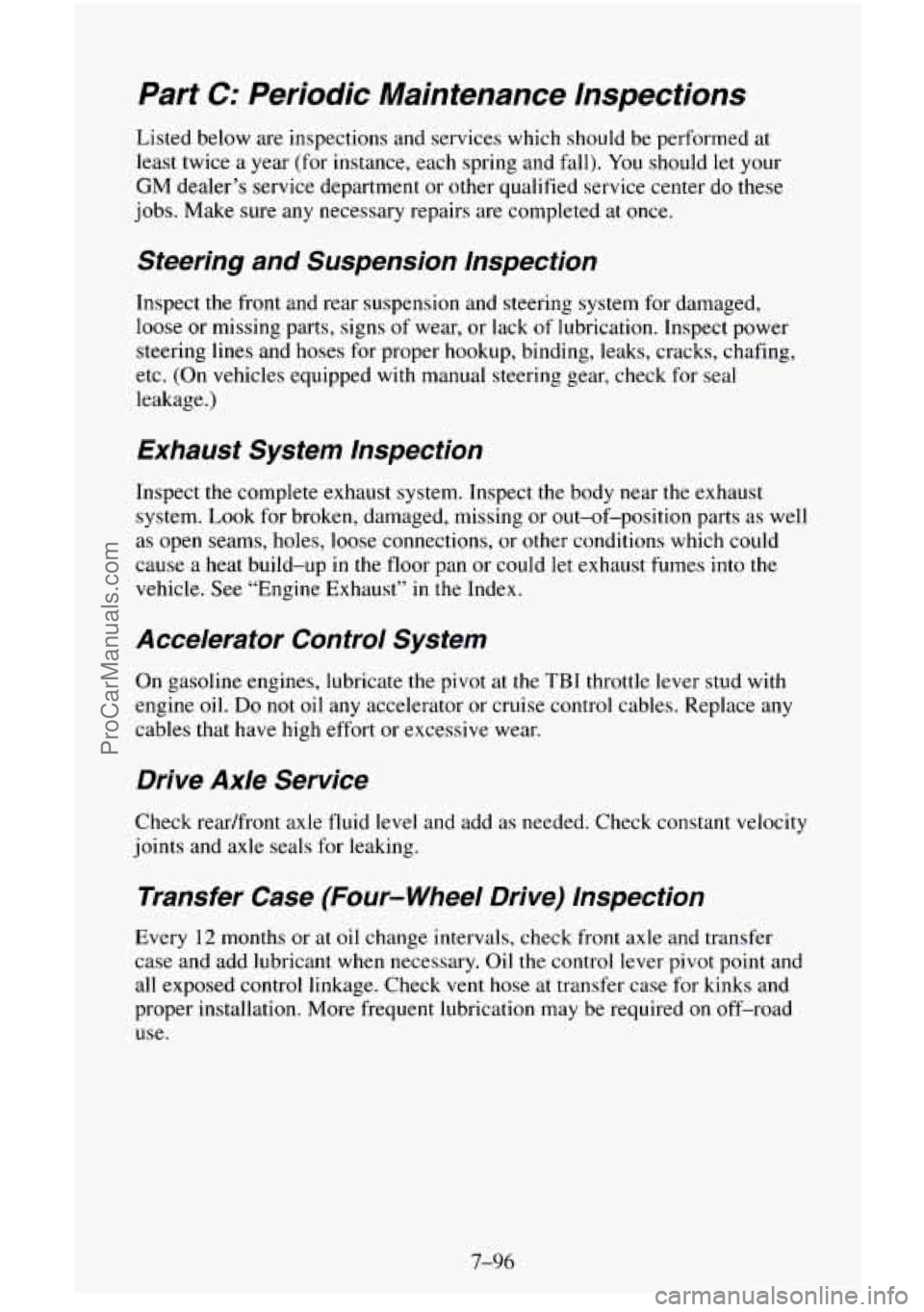
Part C: Periodic Maintenance Inspections
Listed below are inspections and services which should be performed at
least twice a year (for instance, each spring and fall).
You should let your
GM dealer’s service department or other qualified service center do these
jobs.
Make sure any necessary repairs are completed at once.
Steering and Suspension lnspection
Inspect the front and rear suspension and steering system for damaged,
loose or missing parts, signs
of wear, or lack of lubrication. Inspect power
steering lines and hoses for proper hookup, binding, leaks, cracks, chafing,
etc. (On vehicles equipped with manual steering gear, check
for seal
leakage.)
Exhaust System lnspection
Inspect the complete exhaust system. Inspect the body near the exhaust
system.
Look for broken, damaged, missing or out-of-position parts as well
as open seams, holes, loose connections, or other conditions which could
cause
a heat build-up in the floor pan or could let exhaust fumes into the
vehicle.
See “Engine Exhaust’’ in the Index.
Accelerator Control System
On gasoline engines, lubricate the pivot at the TBI throttle lever stud with
engine oil.
Do not oil any accelerator or cruise control cables. Replace any
cables that have high effort or excessive wear.
Drive Axle Service
Check readfront axle fluid level and add as needed. Check constant velocity
joints and axle seals for leaking.
Transfer Case (Four- Wheel Drive) Inspection
Every 12 months or at oil change intervals, check front axle and transfer
case and add lubricant when necessary. Oil the control lever pivot point and
all exposed control linkage. Check vent hose
at transfer case for kinks and
proper installation. More frequent lubrication
may be required on off-road
use.
ProCarManuals.com
Page 461 of 486
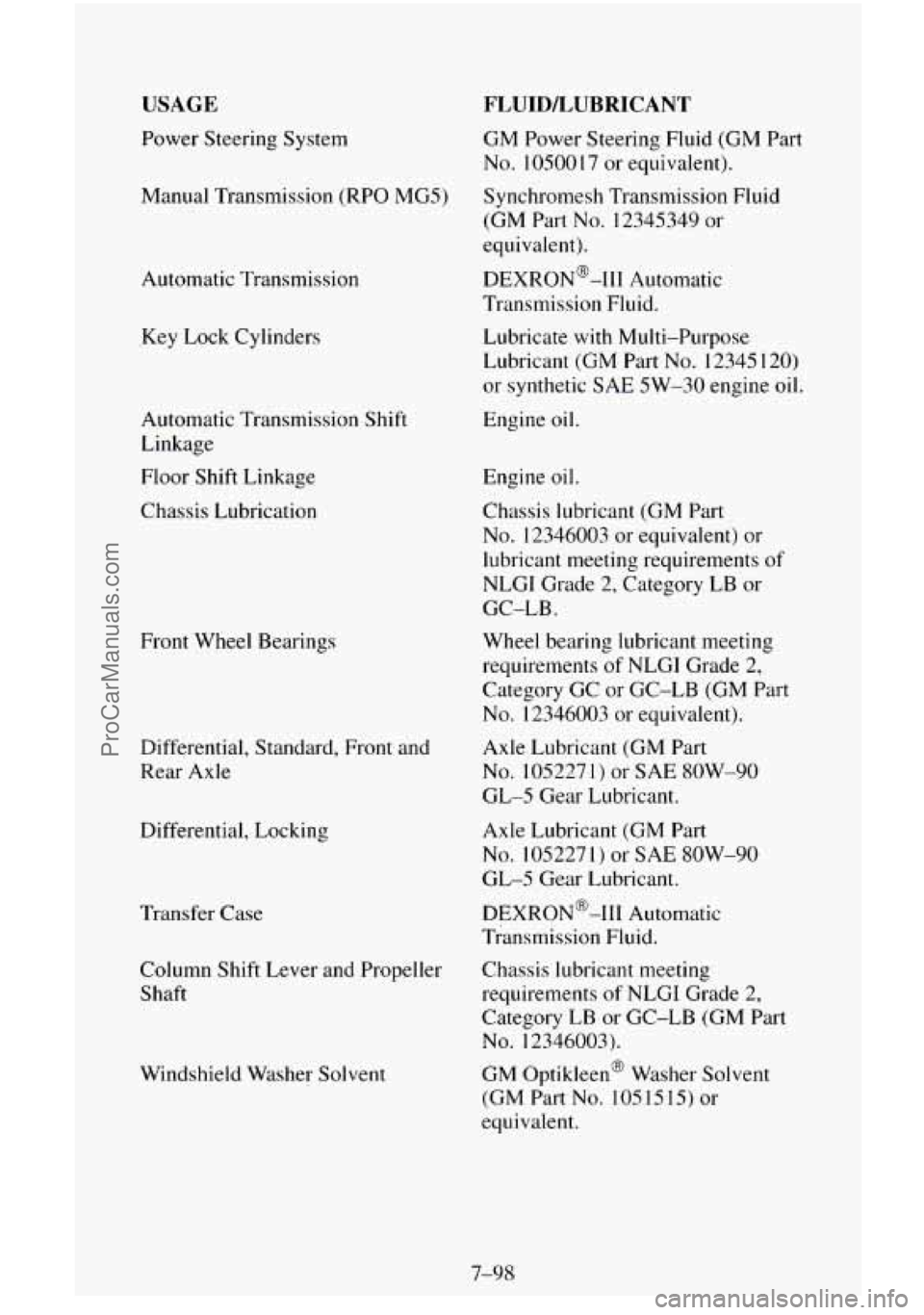
USAGE FLUIDLUBRICANT
Power Steering System
GM Power Steering Fluid (GM Part
No. 10500 17 or equivalent).
Manual Transmission (RPO MG5) Synchromesh Transmission
Fluid
(GM Part No. 12345349 or
equivalent).
Automatic Transmission
.Key Lock Cylinders
Automatic Transmission Shift
Linkage
Floor Shift Linkage
Chassis Lubrication
Front Wheel Bearings
Differential, Standard, Front and
Rear Axle
Differential, Locking
Transfer Case DEXRON@-111
Automatic
Transmission Fluid.
Lubricate with Multi-Purpose
Lubricant (GM Part No. 12345 120)
or synthetic SAE 5W-30 engine oil.
Engine
oil.
Engine oil.
Chassis lubricant (GM Part
No. I2346003 or equivalent) or
lubricant meeting requirements
of
NLGI Grade 2, Category LB or
GC-LB.
Wheel bearing lubricant meeting
requirements
of NLGI Grade 2,
Category GC
or GC-LB (GM Part
No. I2346003 or equivalent).
Axle Lubricant
(GM Part
No. 105227 1) or SAE 8OW-90
GL-5 Gear Lubricant.
Axle Lubricant (GM Part
No. 1052271) or SAE 8OW-90
GL-5 Gear Lubricant.
DEXRON@-111 Automatic
Transmission Fluid.
Column Shift Lever and Propeller Chassis lubricant meeting
Shaft requirements
of NLGI Grade 2,
Category LB or GC-LB (GM Part
No. 12346003).
Windshield Washer Solvent GM Optikleen@ Washer Solvent
(GM Part No. 1051515) or
equivalent.
7-98
ProCarManuals.com
Page 480 of 486
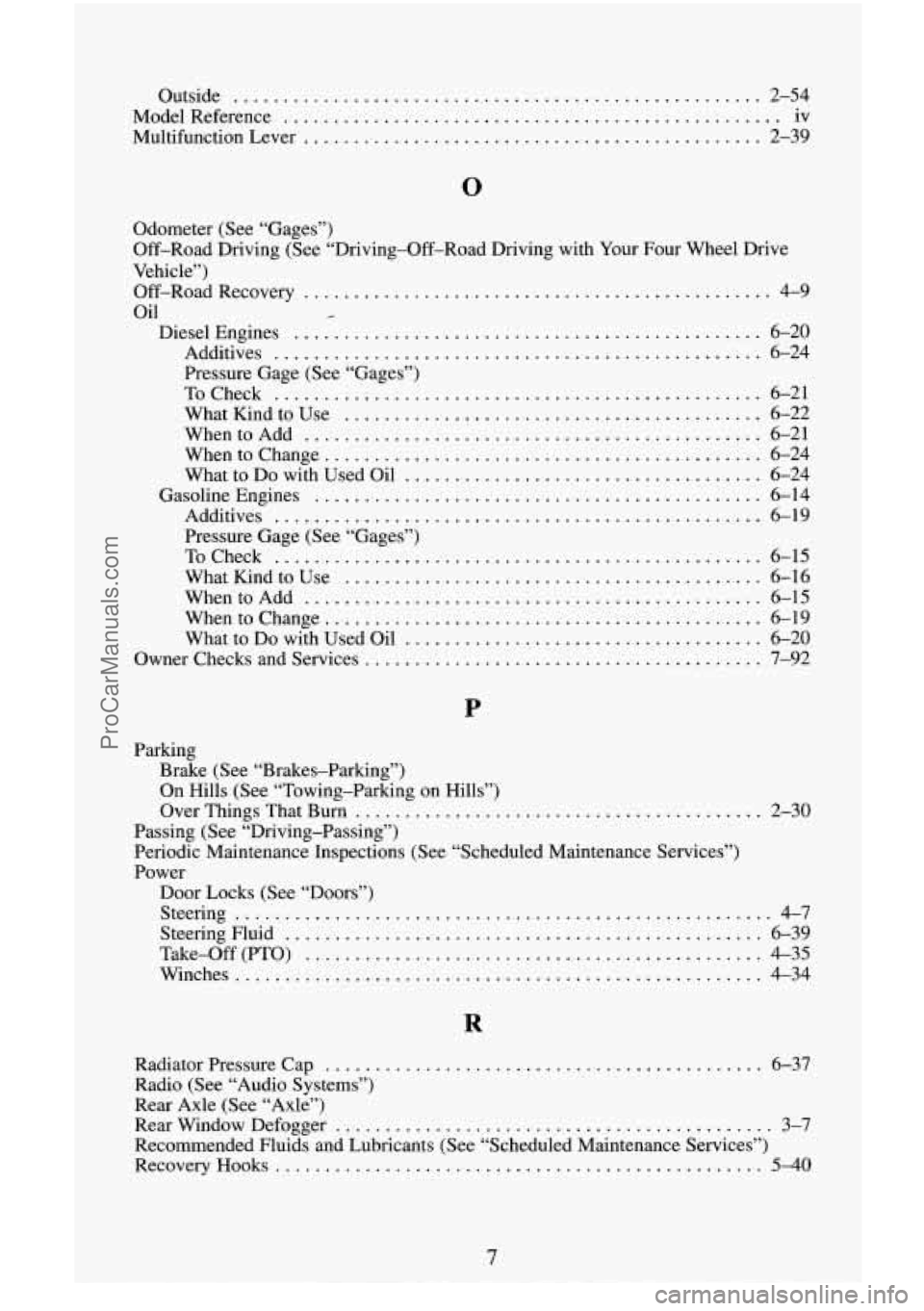
Outside ..................................................... 2-54
ModelReference
.................................................. iv
Multifunction Lever
.............................................. 2-39
0
Odometer (See “Gages”) Off-Road Driving (See “Driving-Off-Road Driving with Your Four Wheel Drive
Vehicle”)
Oil Off-Road Recovery
... , ....... I ............................. 4-9
.
DieselEngines ............................................... 6-20
Additives
................................................. 6-24
Pressure Gage (See “Gages”) ToCheck
............................................... 6-21
WhatKindtoUse
.......................................... 6-22
WhentoAdd
.............................................. 6-21
What to Do with Used Oil
.................................... 6-24
Gasoline Engines
............................................. 6-14
Additives
................................................. 6-19
Pressure Gage (See “Gages”)
ToCheck
............................................... 6-15
WhatKindtoUse .......................................... 6-16
WhentoAdd
.............................................. 6-15
Whentochange ............................................ 6-19
What to Do with Used Oil
.................................... 6-20
Owner Checks and Services
...................................... 7-92
Whentochange
............................................ 6-24
P
Parking
Brake (See “Brakes-Parking”)
On Hills (See “Towing-Parking on Hills”)
Over Things That Burn
......................................... 2-30
Passing (See “Driving-Passing”)
Periodic Maintenance Inspections (See “Scheduled Maintenance Services”) Power
Door Locks (See “Doors”) Steering
...................................................... 4-7
SteeringFluid
................................................ 6-39
Take-Off(PT0)
.............................................. 4-35
Winches
..................................................... 4-34
7
Radiator Pressure Cap ............................................ 6-37
Radio (See “Audio Systems”)
Rear Axle (See “Axle”)
Rear Window Defogger
............................................ 3-7
Recommended Fluids and Lubricants (See “Scheduled Maintenance Services”)
RecoveryHooks
................................................. 5-40
ProCarManuals.com
Page 482 of 486
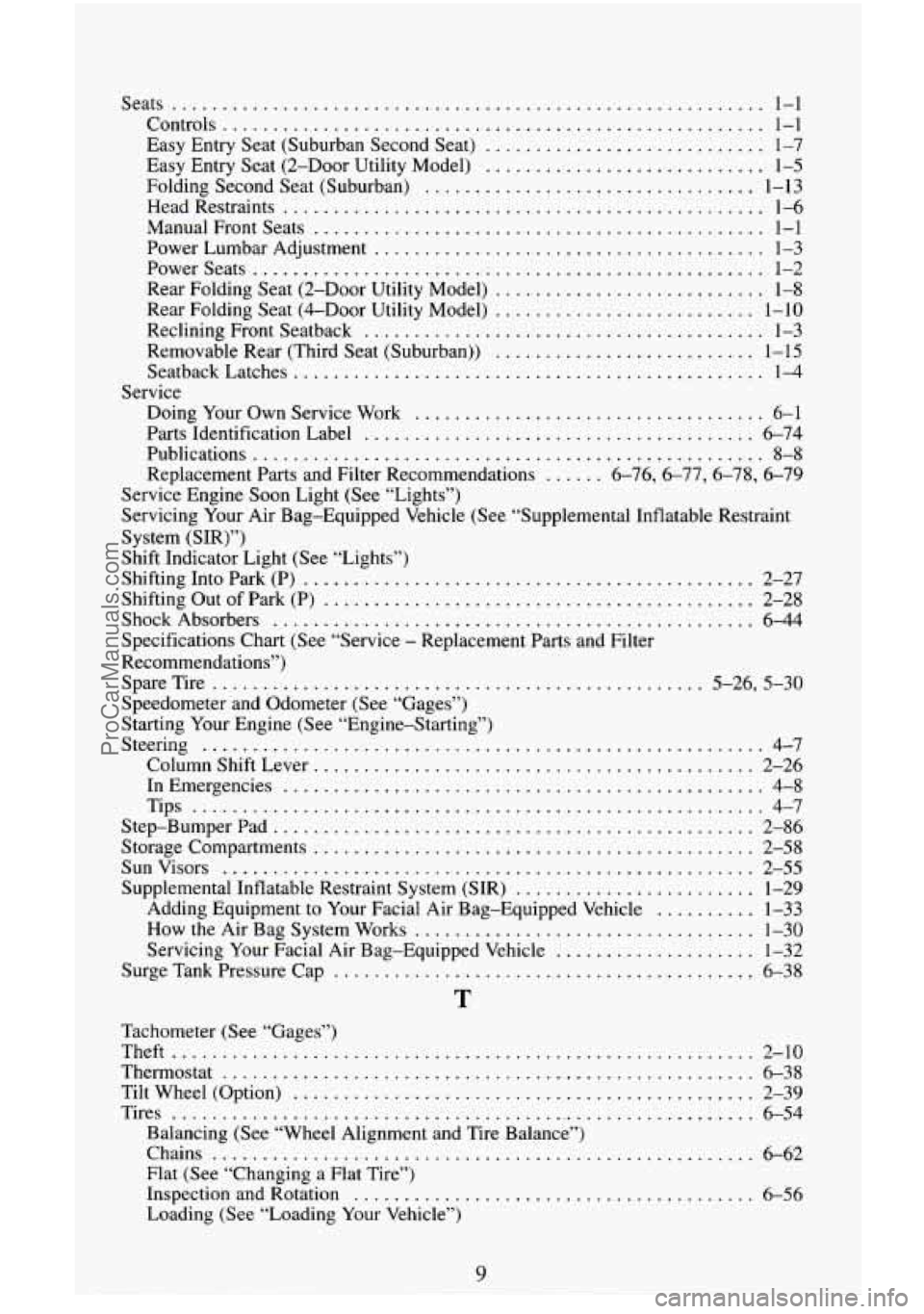
Seats ........................................................... 1-1
Controls ...................................................... 1-1
Easy Entry Seat (Suburban Second Seat)
............................ 1-7
Easy Entry Seat (2-Door Utility Model)
............................ 1-5
Folding Second Seat (Suburban) ................................. 1-13
Head Restraints
................................................ 1-6
ManualFrontSeats
............................................. 1-1
Power Lumbar Adjustment
....................................... 1-3
Powerseats ................................................... 1-2
Rear Folding Seat (2-Door Utility Model) ........................... 1-8
Rear Folding Seat (&Door Utility Model)
.......................... 1-10
Reclining Front Seatback
........................................ 1-3
Removable Rear (Third Seat (Suburban))
.......................... 1-15
SeatbackLatches
............................................... 1-4
Doing Your Own Service Work ................................... 6-1
Parts Identification Label
....................................... 6-74
Publications
................................................... 8-8
Replacement Parts and Filter Recommendations
...... 676,677, 6-78, 6-79
Service
Service Engine Soon Light
(See “Lights”)
Servicing Your Air Bag-Equipped Vehicle (See “supplemental Inflatable Restraint
System (SIR)”)
Shift Indicator Light (See “Lights”)
Shifting Into Park (P)
............................................. 2-27
Shifting Out of Park (P)
........................................... 2-28
Shock Absorbers
................................................ 6-44
Specifications Chart (See “Service - Replacement Parts and Filter
Recommendations”) SpareTire
................................................. 5-26, 5-30
Speedometer and Odometer (See “Gages”)
Starting Your Engine (See “Engine-Starting”)
Steering
........................................................ 4-7
Column Shift Lever
............................................ 2-26
In Emergencies
................................................ 4-8
Tips
......................................................... 4-7
Step-BumperPad
................................................ 2-86
Storage Compartments
............................................ 2-58
Sunvisors ..................................................... 2-55
Supplemental Inflatable Restraint System (SIR)
........................ 1-29
How the Air Bag System Works
.................................. 1-30
Servicing Your Facial Air Bag-Equipped Vehicle
.................... 1-32
Surge Tank Pressure Cap
........................... , ............ 6-38
Adding Equipment to
Your Facial Air Bag-Equipped Vehicle
.......... 1-33
T
Tachometer (See “Gages”)
Theft
.......................................................... 2-10
Thermostat
..................................................... 6-38
Tilt Wheel (Option)
.............................................. 2-39
Tires
........................................................... 6-54
Balancing (See “Wheel Alignment and Tire Balance”)
Chains
...................................................... 6-62
Flat (See “Changing a Flat Tire”)
Inspection and Rotation
.........................
Loading (See “Loading Your Vehicle”)
.......... 6-56
ProCarManuals.com